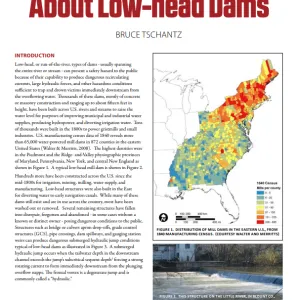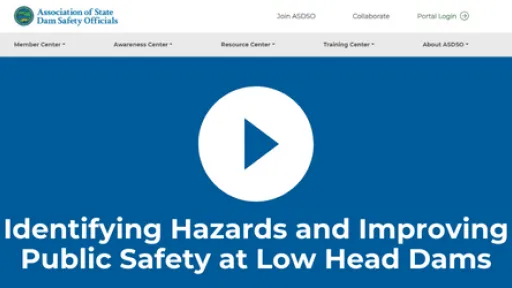Hazardous hydraulic conditions, such as hydraulic rollers, can occur at dams of all sizes.
Research conducted by the late Dr. Bruce Tschantz shows that between 1980 and 2016 there have been more than nine times the number of fatalities that have occurred at dams than have occurred due to dam failures: 347 reported drownings at dams versus 40 deaths from dam failures. These figures only include accidents identified by Dr. Tschantz from news articles or reported to him by local officials. Most of these accidents occurred at low-head dams which was the focus of his research. The actual number of accidents is unknown and is likely much higher, but collective statistical data is lacking.
In some instances, specific low head dams have been the site of multiple drownings, yet many of these dams continue to operate without modification to mitigate the hydraulic hazards. For example, South Island Dam on the Kankakee River in Illinois, Midtown Dam on the Red River in North Dakota, Glen Palmer Dam on the Fox River in Illinois, and Dock Street Dam on the Susquehanna River in Pennsylvania have each claimed more than 15 lives. At the Dock Street Dam alone, 29 fatalities and several serious injuries have recently been documented (Vendel, 2018). Of significant concern are the growing populations near these types of structures and the increasing online postings of extreme sports activities by youth in and around restricted industrial sites at water control structures. The research of Dr. Tschantz shows a disturbing trend that the rate of documented incidents from hydraulic hazards at dams is increasing.
Between 1980 and 2016, there were more than nine times the number of fatalities that have occurred at dams than have occurred due to dam failures. - Dr. Bruce Tschantz
Most of the incidents at dams occur due to transient hydraulic conditions that have not been identified or addressed by the dam owner. In other words, hazardous hydraulic conditions do not normally occur at the dam, but occur unexpectedly because of changes in operation or hydrologic circumstances. Many of the victims in these incidents are recreators and other members of the public who are ill-prepared for, or even oblivious to, the hazard. Sometimes, people return to areas where they have previously enjoyed recreating without incident, only to fall victim because conditions have changed resulting in hydraulic hazards. Victims have also commonly included expert swimmers, first responders, and other professionals equipped with state-of-the-art life-saving and rescue gear who were aware of the hazards but still succumbed to the lethal hydraulic forces. Seven types of hydraulic hazards at dams that have resulted in loss of life have been identified (Schweiger et al, 2017). The identified hazards are as follows:
- Hydraulic Roller. Typically, a hydraulic jump is formed downstream of a dam to dissipate the excess energy and return the flow to subcritical conditions. When the jump is in the submerged state because of the presence of tailwater, a strong reverse roller can form at the downstream face of the dam. The roller from a submerged hydraulic jump can feature an upstream directed surface velocity that is strong enough to trap debris or people near the face of the dam. The rolling water takes any object, including a person, to the bottom of the stream, releases it to the surface, draws it back to the face of the dam, and then pushes it back to the bottom. This cycle is a function of streamflow and can continue for an extended period. Air bubbles mixing in the water can decrease buoyancy by as much as one-third (Wright et. al., 2003). The victim may therefore have a difficult time staying afloat, even with a life jacket. These factors combined with the recirculating current create a nearly inescapable condition.
- Swift Current over Spillways. Overflow spillways are particularly dangerous as they may be difficult to recognize or may not be visible from above the dam. Dams without piers and other structure indicators can make a submerged spillway difficult to identify by upstream boaters until it is too late. A condition referred to as an “infinity pool” can occur, where the edge of the spillway is not visible from upstream. If the crest of the spillway is left unmarked and unprotected, boaters in the reservoir can be drawn over the spillway. Jet skiers and power boats have driven off the crest of spillways unaware of the sudden drop with tragic consequences. More often, motor boaters experience engine problems, lose control of their boats, and are carried over the spillway by the current.
- Strainers. Excessive seepage or leakage paths through a dam can create a danger to swimmers or divers even during normal conditions. A swimmer or diver can become trapped against the upstream face of the dam, trashracks or other features by the suction created as the result of substantial seepage or leakage. Swimmers and divers can also become trapped in strainers created by fallen trees and other debris that tend to accumulate at dams. Water passes through the debris, but solid objects like boats or people can become trapped.
- Sudden Releases and Stranding. Sudden discharge releases from dams by opening gates or outlet works can create a fast moving and deadly flood wave that can overwhelm and kill unsuspecting victims recreating or working downstream. The rapidly changing water levels and velocities can also result in downstream users being stranded on opposite shores from where they entered, or on islands within the river system.
- Flow into Conduit Openings. The inlets to conduits can be extremely dangerous to swimmers, divers and boaters. From the surface, such areas may provide little visible evidence of the dangerous undercurrents and suction. Once sucked into or against the conduit opening, it is virtually impossible to overcome the hydraulic pressure, and the victim can become trapped and drown or be fatally injured from passing through the conduit.
- Entrapment from Buoy Lines and Other Flow Control Structures. Similar to strainers, water surface flow velocities under or through buoy lines and other flow control structures such as debris booms and fish screens can trap, submerge, or capsize boaters, kayakers, canoers, and persons tubing or using other watercraft under certain flow conditions. Although these features are often installed as public safety features, if they are incorrectly configured, they create a hazard. For example, a buoy line installed upstream of a dam in a straight line from bank to bank normal to the flow can bulge at the center and create an entrapment that forces floating objects (including boaters) against the buoy line. If the surface current is fast enough, it can capsize the trapped object under the line and push it downstream.
- Flow under Lock Gates and Gate Openings. Similar to flow entering conduits, headgate structures near entrances to locks, spillways and intake structures create hazards as water flows under or through the gate openings. An undercurrent, undertow, or sudden and unexpected discharge can occur when the gates are raised, especially if done under remote or automatic control. These conditions can impact both swimmers and boaters upstream of these structures.
Dam owners, regulators, and others in the dam safety industry need to focus on identifying and correcting hazardous hydraulic conditions created by dams. Many ways have been identified to either minimize or even eliminate the risks associated with each of these hydraulic hazards (Schweiger et al, 2017). These can include structural modifications to a dam, installation of public safety appurtenances such as buoy lines or warning signs, establishment of appropriate operating and maintenance procedures, and emergency planning to facilitate rescue efforts among other things. Continual efforts should be made to educate both emergency responders and the general public about the unseen dangers that can exist at and around dams and other hydraulic structures.
References:
(1) Leutheusser, H.J. (1988). Dam safety, yes. But what about safety at dams?. Hydraulic Engineering Proceedings. American Society Of Civil Engineers.
(2) Leutheusser, H.J., & Birk, W.M. (1991). Drownproofing of low overflow structures. Journal of Hydraulic Engineering, 117(2). American Society Of Civil Engineers.
(3) Leutheusser, H.J., & Fan, J.J. (2001). Backward flow velocities of submerged hydraulic jumps. Journal of Hydraulic Engineering, 127(6). American Society Of Civil Engineers.
This lesson learned was peer-reviewed by Paul G. Schweiger, P.E., CFM, Gannett Fleming, Inc.






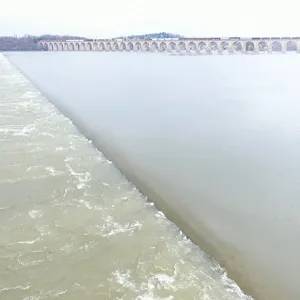
Dock Street Dam (Pennsylvania)
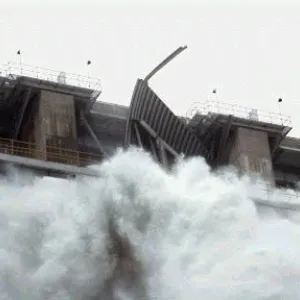
Folsom Dam (California, 1995)

Front Range Flood (Colorado, 2013)
Additional Case Studies (Not Yet Developed)
- Island Farm Weir (New Jersey, 1995-1998)
- Big Wills Creek Low Head Dam (Alabama, 2015)
- Lake Linganore Dam (Maryland, 2015)
- House Creek Low Head Dam (Texas, 2017)
- Oswego River Hydroelectric Dam (New York, 2010)
- Lake Wanahoo Dam (Nebraska, 2012)
- Lac St. Jean Dam No. 7 (Quebec, 2008)
- Melvin Price Lock and Dam (Illinois, 2016)
- Tom Miller Dam (Texas, 2005)

Evaluation of Public Safety at Run-of-River Dams

Guidelines for Public Safety at Hydropower Projects

Public Safety Around Dams: Best Management Practices

Don't Go with the Flow! Identifying and Mitigating Hydraulic Hazards at Dams
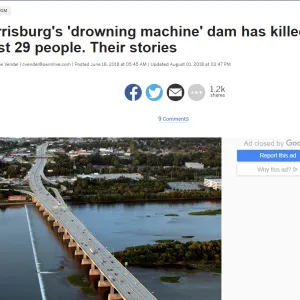
Harrisburg’s ‘Drowning Machine’ Dam has Killed at least 29 People. Their Stories.
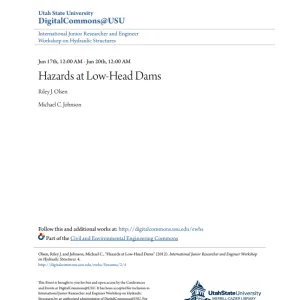

Hidden Dangers and Public Safety at Low-Head Dams
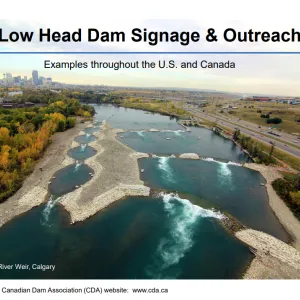
Low Head Dam Signage & Outreach

Scoping Report: Public Safety of Low-Head Hydraulic Structures
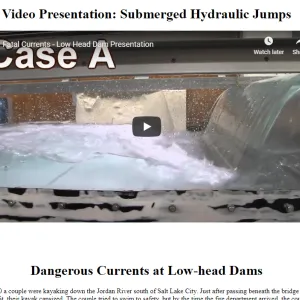
Submerged Hydraulic Jumps: Summary and Incident Database
